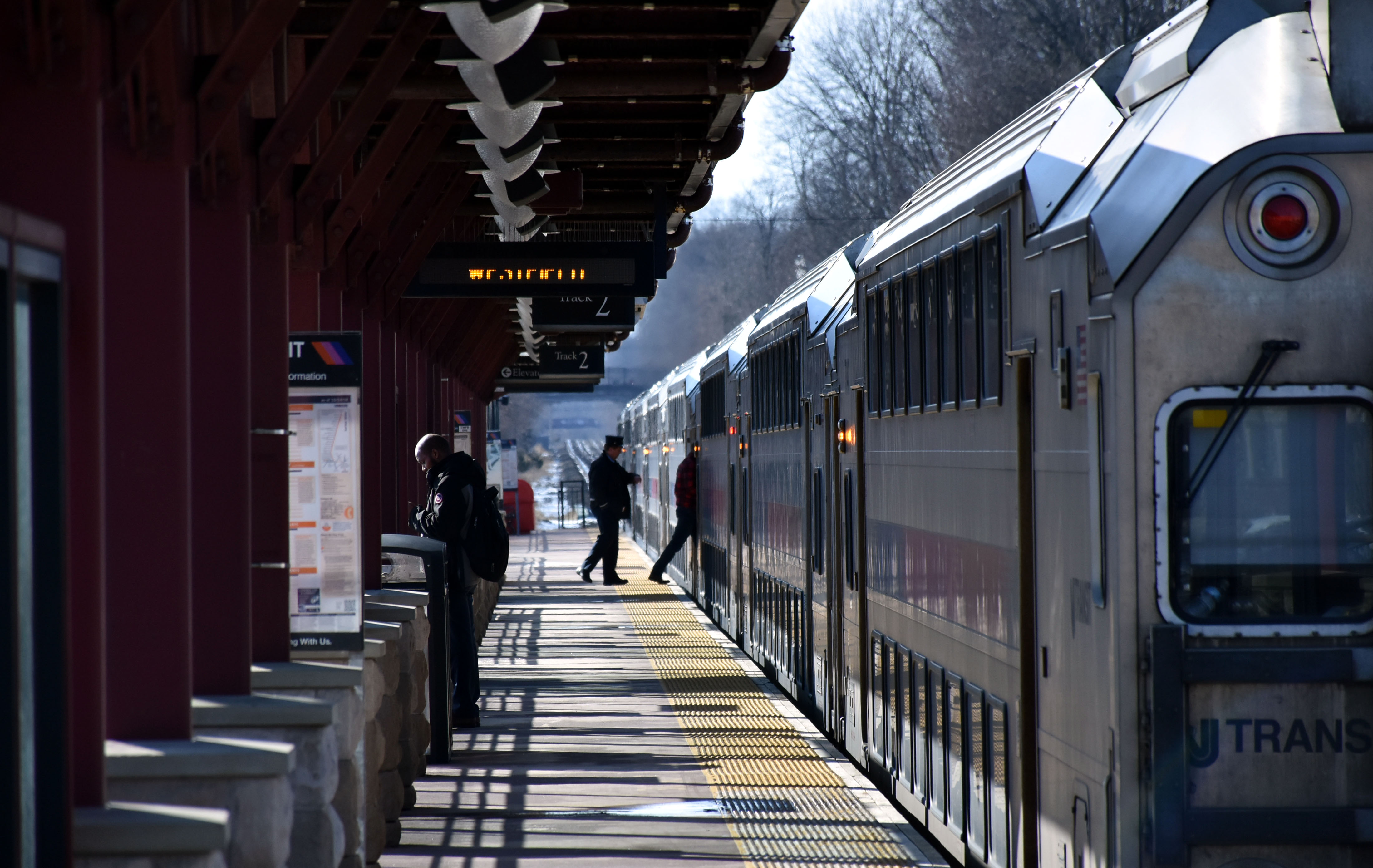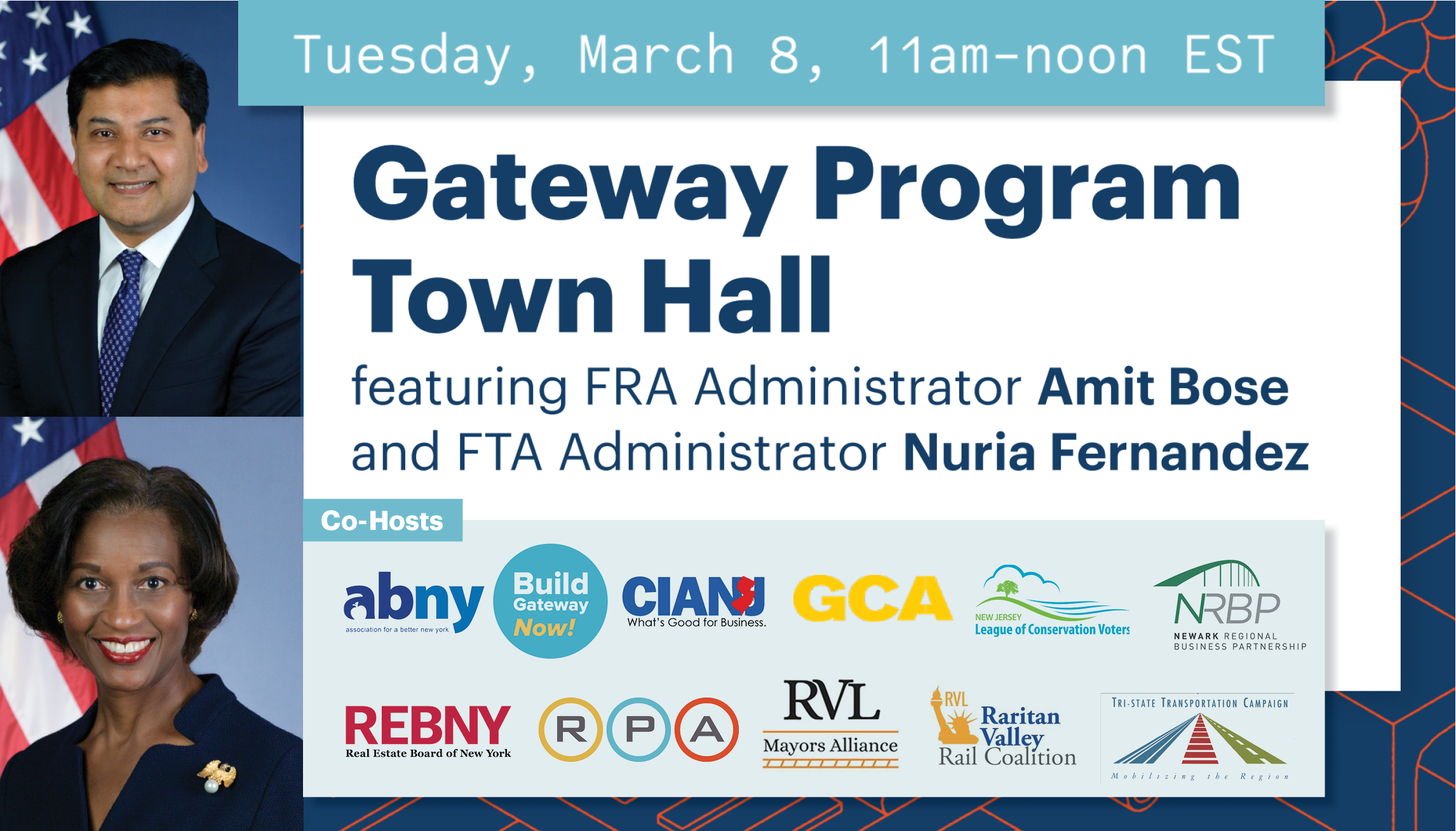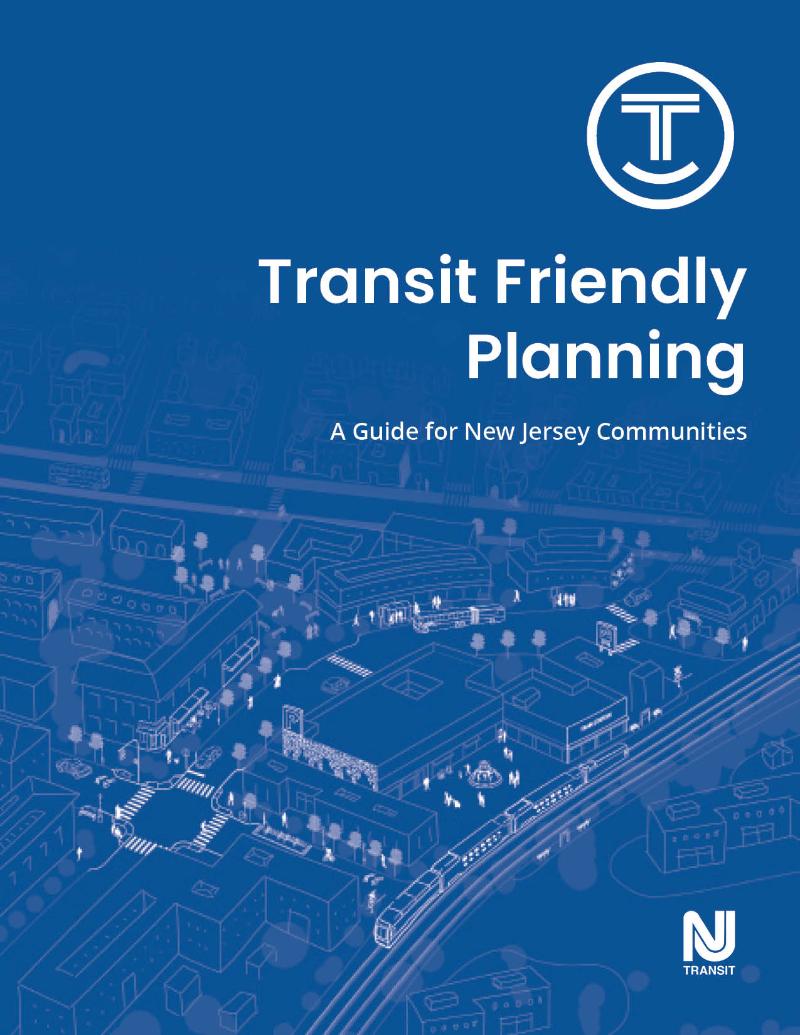RVRC Chairman Bruce Bergen joined multiple organizations and elected officials providing their comments and suggestions in response to NJ TRANSIT’s proposed 15% fare hike and fare policy adjustments. Included in the letter are the four recommendations:
- Refrain from voting on the double-digit fare hike proposal and work in tandem with Governor Murphy and the Legislature on the agency’s budget. Collaboration will ensure that budget decisions are not siloed, especially considering the agency is required by law to send their budget proposal to the Legislature by April 1, before the proposal is voted on.
- Roll back any future fare hikes to a more reasonable annual increase, with lower rates for local bus routes. Fare increases should be phased in for riders so they are incremental and predictable. A lower increase for local bus routes would also spare riders with the lowest incomes; this approach was used during the Christie Administration when fares increased in 2015.
- Save the FlexPass and reverse the proposed 30-day expiration on all one-way tickets. The agency has not shown sufficient evidence that these changes would generate significant revenue, but both would burden riders who rely on the flexibility and savings.
- Commit to holding hearings on any future fare hike, with a virtual option, even those proposed in perpetuity. The question should not be whether or not it is legal to hold one hearing for a recurring fare increase – it is simply the right thing to do. Additionally, commit to offering at least one virtual hearing option to ensure everyone can be heard regardless of their ability to attend an in-person meeting.
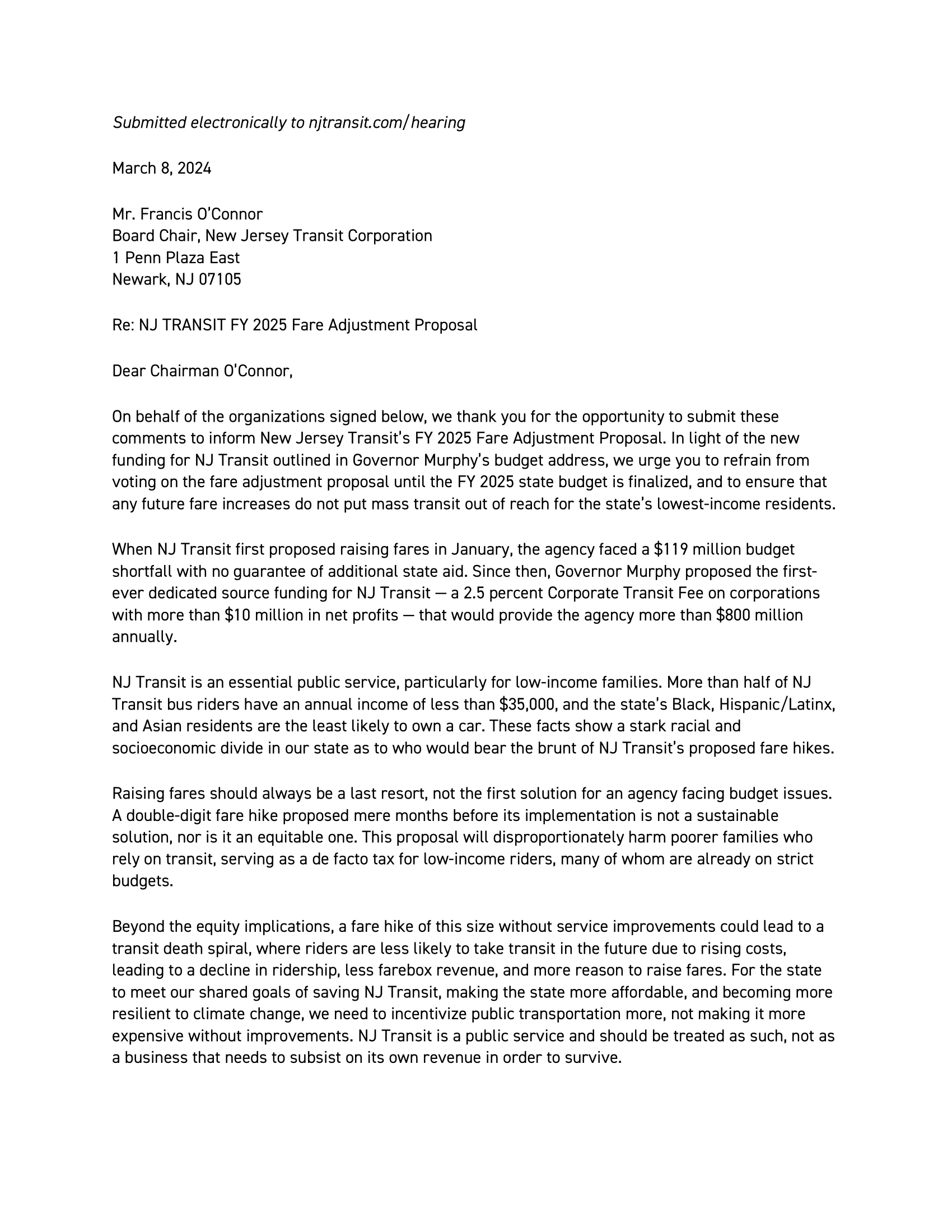
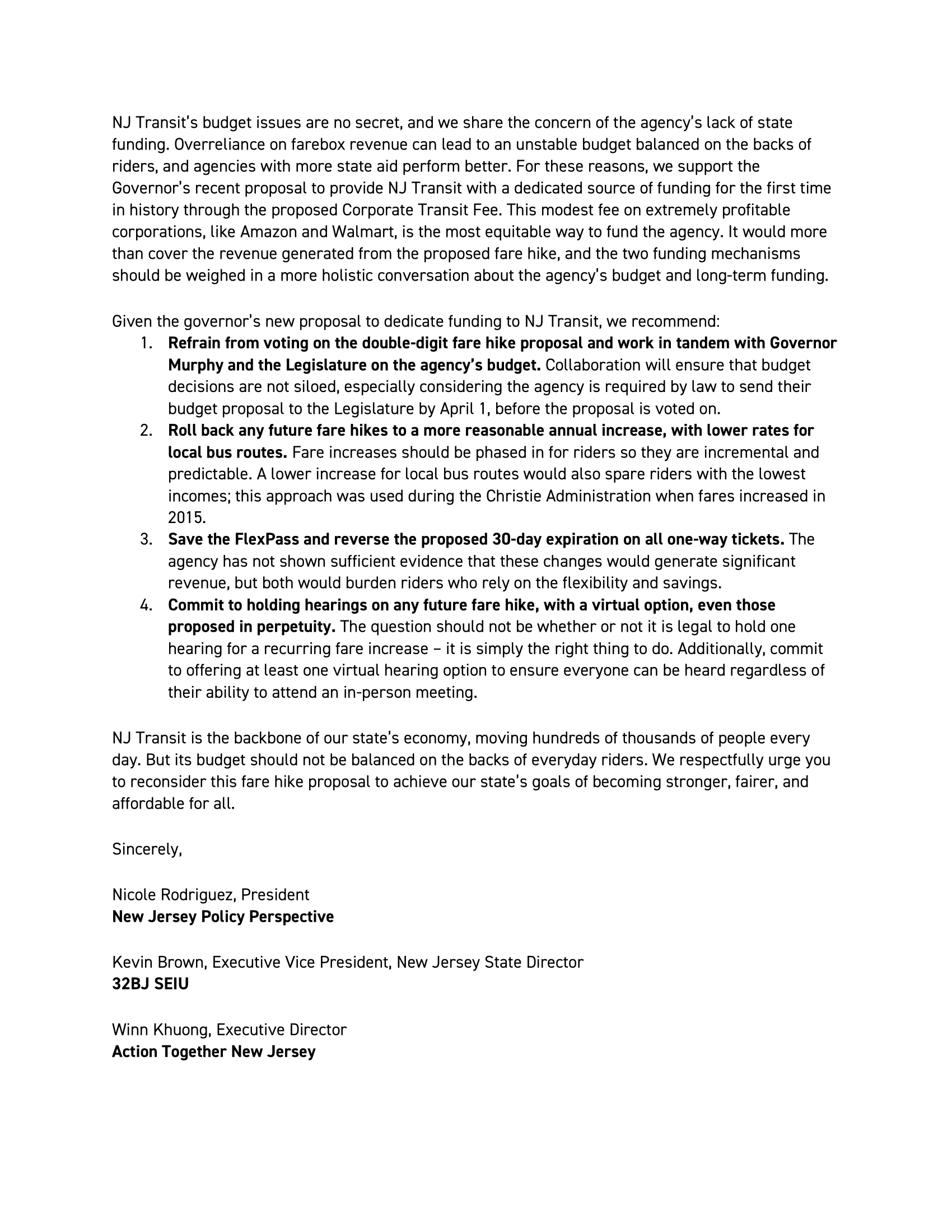
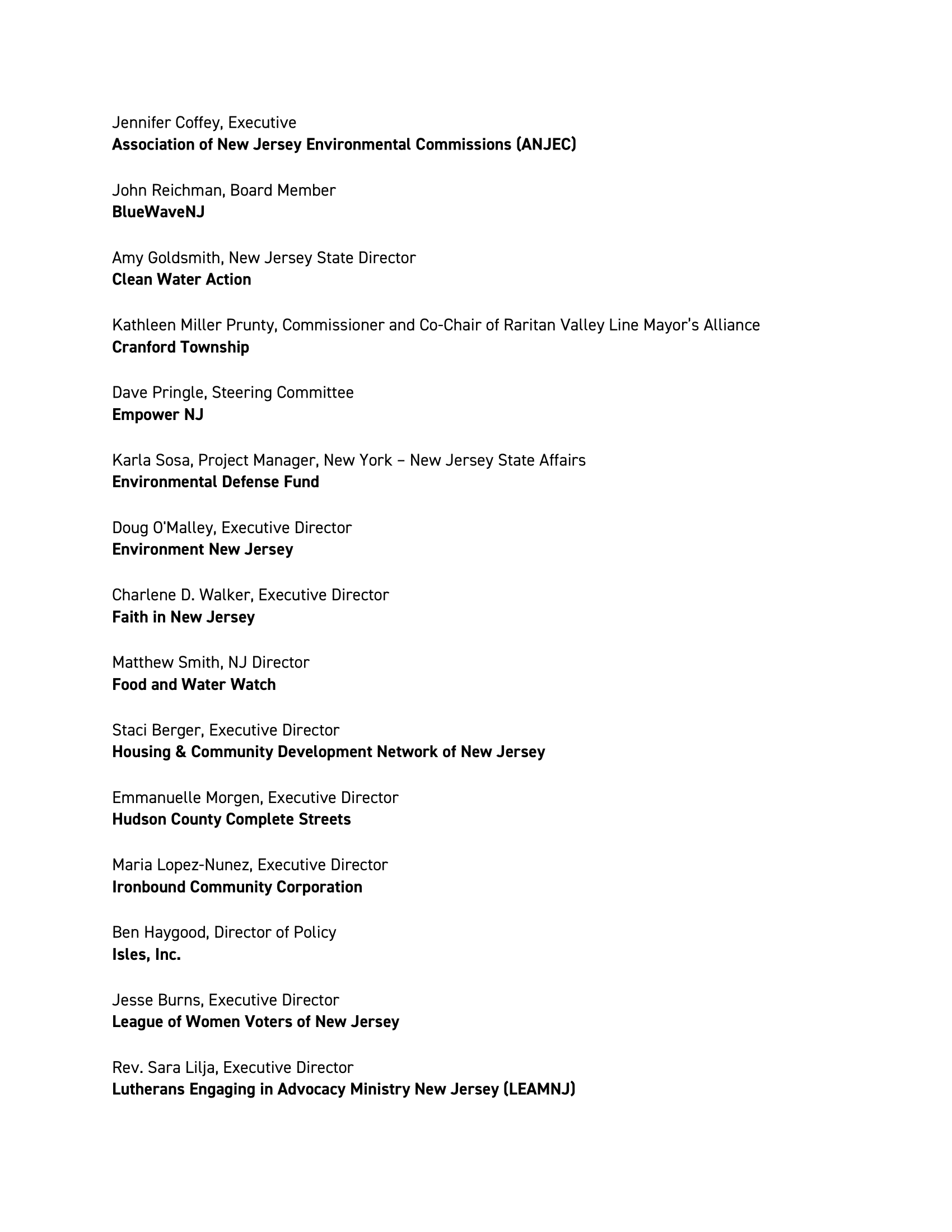
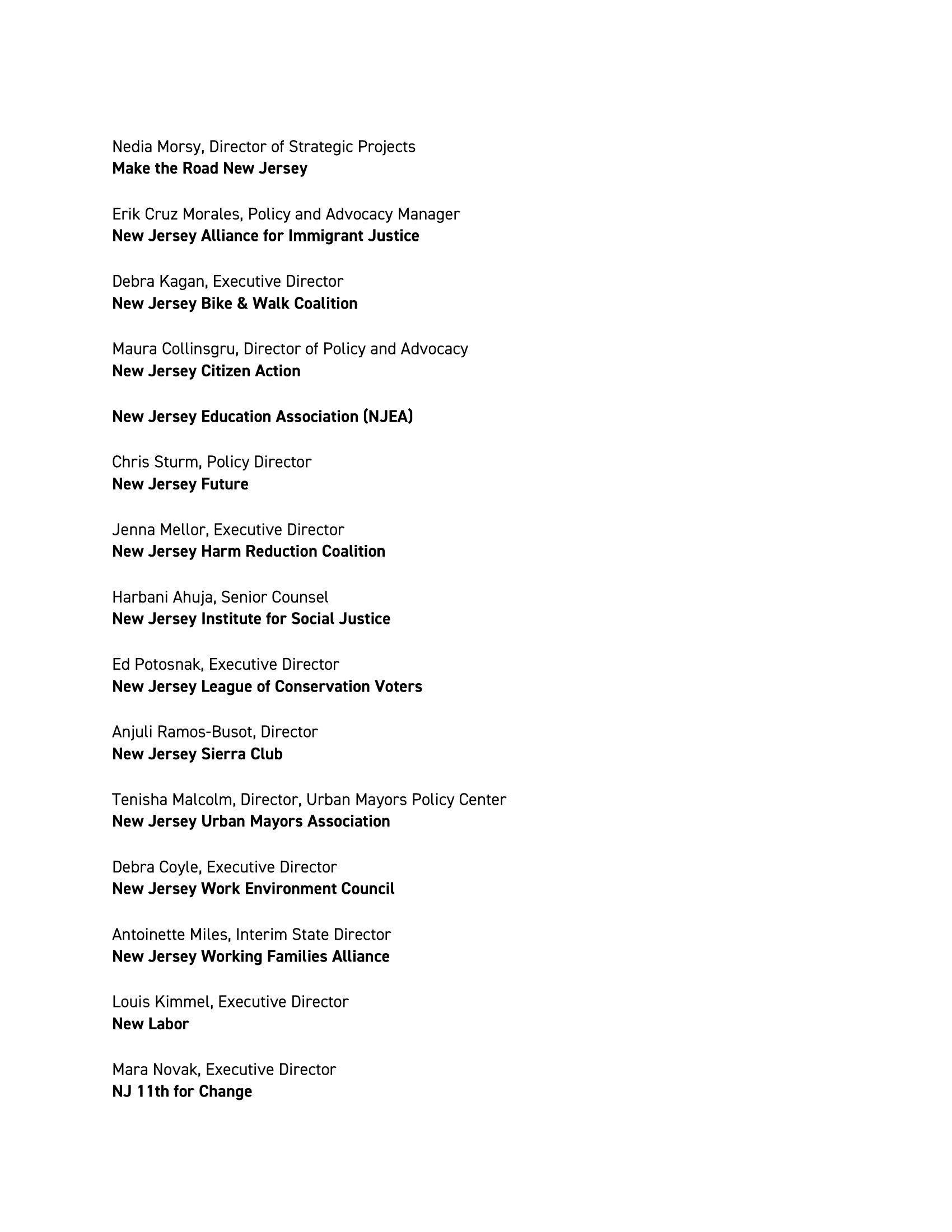
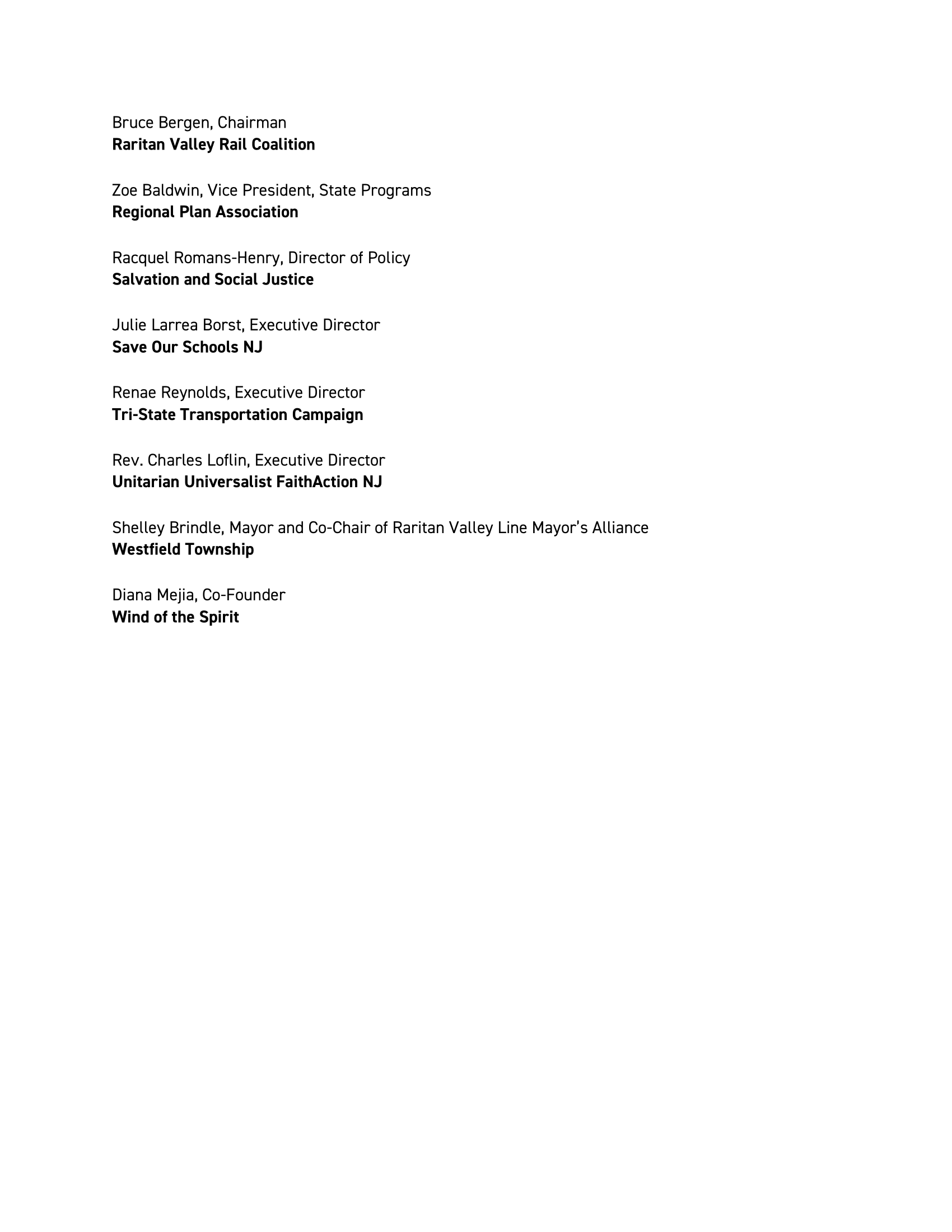

NJ TRANSIT is proposing a systemwide fare adjustment of 15 percent taking effect on July 1, 2024
You can submit your comments online or attend one of their public hearings across the state.
Let your voices be heard – njtransit.com/hearing
NJ.com – Gateway commission approvals include $692M for last part of concrete box
Larry Higgs – For The Star-Ledger
The cost estimate approval will lead to construction
of last third of a larger tunnel box project.
President Joe Biden came to New York in January to
announce a $292 million grant to build the remaining
piece of a concrete structure to carry the proposed
Gateway Tunnel under the massive Hudson Yards
complex in west Manhattan.
On Tuesday, the Gateway Development Commission
approved three resolutions that will lead to construction
of the last third of a larger tunnel box project that was
started in 2013. The agreements include approving a
market-based cost estimate of $692.7 million and an
agreement on how the funding will be divided between
New York, New Jersey and Amtrak.
The tunnel box section extends diagonally from 11th
Avenue to 30th Street under a Long Island Rail Road rail
yard on west Manhattan. That section passes below the
MTA train yard that was the site of Biden’s January event
announcing the grant.
The Hudson Yards Concrete Casting 3 would be
approximately 550 feet long, between 50 and 65 feet wide
and between 27 and 38 feet high. The project involves
building the “box out of heavily reinforced concrete
ranging from 3.5- to 10-feet thick” and a waterproofing
membrane to cover its perimeter, Gateway Development
Commission documents show.
How will it be funded? Under the agreement approved by
the commission’s board of directors, New Jersey and New
York will each fund $69.27 million. Amtrak applied for
and was awarded a $292.1 million mega grant for the last
phase of the tunnel box, which Eiden announced during
his January visit. That grant will be Amtrak’s
contribution.
However, the agreement said that Amtrak would fund
any costs of the project that exceed the states shares and
the Mega Grant, including any costs that exceed the $692
million Market Case Estimate. That could potentially put
the national passenger railroad corporation on the hook
for $262.1 million.
The tunnel box won’t include “operational rail
components,” such as tracks, lighting, ventilation or
electrical systems. Temporary lighting, ventilation and
drainage will be provided to complete the work.
Building the tunnel box to preserve the tunnel route
became critical in 2013 as the foundations for the Hudson
Yards complex were starting to be built. The second part
of the tunnel box was completed in 2016.
The Biden administration’s proposed federal budget
contains including $700 million for the Gateway rail
tunnel, which is on top of $400 million announced by
Biden in January, and another $100 million previously
awarded, for a total of $1.2 billion for Gateway, Biden
administration officials said in March.
While the Federal Transit Administration in January
raised its rating for Gateway to medium-high, making it
eligible for federal funding, there are still several steps to
be taken with the states of New Jersey and New York and
other agencies involved in construction before the U.S.
writes its first check.
Gateway officials hope to have a coveted PTA full funding
agreement for the tunnel project in place in 2024.
Officials said they’ve also applied for three other federal
grants through the Rebuilding American Infrastructure
with Sustainability and Equity, the Consolidated Rail
Infrastructure and Safety Improvements programs and
Federal-State Partnership for Intercity Passenger Rail
Grant Program grant available under the Bipartisan
Infrastructure Law, which would reduce overall costs of
the project.
Gateway officials also released very tentative schedules
for the four segments of the tunnel project that calls for
three that do preparatory work for the actual drilling
starting in 2024. Actual drilling of the tunnel under the
river, which will use twin tunnel boring machines
working from New Jersey to New York, would start in late
2025 and end in spring 2029.
The recent announcement that one of the project’s prime
sponsors and operators, NJ Transit, is facing projected
fiscal problems as early as mid-2025 prompted a warning
about getting a federal grant, said a transit advocate.
Part of the federal grant process is to prove NJ Transit,
the tunnel operator, will have the financial resources
needed to operate the project when completed, said Joe
Clift, a former Long Island Rail Road planning director
and advocate.
“I ask you to press New Jersey government to solve the
$920 million hole,” Clift said. “NJ Transit doesn’t have a
problem for two years but you do. To move through the
(federal grant) process, you have to look at financial
pressure NJ Transit has. That hole may be a problem.”
On Tuesday, Gov. Phil Murphy said officials are still
determining how to close the shortfall.
“It’s gonna be a multi-pronged approach to addressing
that so-called fiscal cliff,” Murphy said after an unrelated
event in Paramus. “I’m actually an optimist that we’ll be
able to get there in a reasonable and responsible way.”
Murphy added the proposed state budget that is being
reviewed by the state Legislature includes no fare hikes
for the sixth year in a row.
NJ Advance Media staff writer Brent Johnson contributed
to this report. Larry Higgs, NJ Advance Media,
lhiggs@njadvancemedia.com
NJ.com – NJ Transit explains highest ratings in rider survey. Issues still remain, advocates say.
Article by Larry Higgs | NJ Advance Media for NJ.com
NJ Transit officials said the agency received its highest rider satisfaction rankings since 2011, the year it began conducting surveys, and in an unusual move, officials provided a deep dive into the specific work done to address issues customers raised in previous surveys.
The 35,000 riders who took the survey in the spring of 2022 gave the agency its highest overall satisfaction ranking of 6.8, on a scale of where 10 is the highest score and 1 the lowest. That represented an increase from 5.9 in fall 2019 and 5.8 in spring 2019.
Despite the high scores, transit advocates interviewed said the agency still has issues that need to be addressed.
“I think the agency has improved in many ways since 2018, but that it still has a long way to go in terms of addressing riders’ concerns,” said commuter Adam Reich, an independent transit advocate.
This survey was the first one since the COVID-19 pandemic where the agency returned to asking riders to rate 40 different service aspects. Surveys conducted during the height of the pandemic focused primary on how riders traveled before and during the pandemic and when those with remote or hybrid work arrangements expected to return to workplaces.
The survey had some COVID related questions and answers too. Due to hybrid work arrangements between offices and home, commuters said were more likely to travel earlier in the week than later in the week.
“The percentage of weekday trips drops off by Friday and are highest on Monday and Tuesdays,” said Susan O’Donnell, a NJ Transit business analysis and research senior director.
That varies by transit type. Local bus riders, which includes many essential workers who were riding during the height of the pandemic, are still making the trip, as 73% said their job duties require them to be at their office or workplace. Of Interstate bus commuters, 47% said they were required to work from their workplace.
Commuter rail riders had the lowest number, with 31% saying their job required them to come to a workplace. Light rail was next lowest at 42% saying they had to be on site.
Results of the spring 2022 survey were discussed by the board of directors’ customer service and operations committee on Friday, but have not yet been posted on the agency’s website.
Rail riders surveyed said passenger information, schedules and cleanliness were the to three areas that need improvement. Light rail passengers also named the first two issues as rail riders and added security as a third for improvement. Bus passengers identified schedules, employees and passenger information as areas for improvement.
“Their on-line communications, such as Departure Vision, due to the Portal Bridge outage last week was especially deplorable,” said Joe Versaggi, New Jersey Association of Railroad Passengers president. “Their customer service responses are simply canned, boilerplate, out of a script, and do not bring about change in performance.”
Others said the unaddressed issue highlight the need to fill the Customer Advocate’s position which has been vacant since October 2020.
“We need public forums, a Customer Advocate and the Customer Advisory board to facilitate meaningful and regular dialogues with the agency,” said Reich, who questions the status of that position every month. “These presentations highlight the items agency officials want to discuss and frequently leave out or overlook other notable ridership concerns.”
NJ Transit’s directors of bus, commuter rail and light rail talked about specific work that had been done on each system to address areas where riders had given low marks.
“Part of the (bus) rebuild is driven by customer surveys like this,” said Michael Kilcoyne, director of bus operations. “We completely reconstructed the run time on 200 bus routes over 18 months.”
That work allows for recovery time to make up for traffic and other incidents and reduce delays, he said.
Some route redesigns included adding Sunday service on eight lines, extending six Newark routes to the Penn Station bus lanes, he said. Changes were made to the #1 route to match employees shifts at workplaces on the route, he said.
Other action includes deploying the agencies new, larger articulated buses that haul more passengers, putting them on the 1 Route, the 126 Hoboken-New York route, the 119 Bayonne-Jersey City-New York and the 123 Jersey City-New York routes, he said.
“Passengers no longer have to wait for a second bus,” he said.
New “cruiser” style buses have been put on Bergen County bus routes that had “some of oldest buses in the fleet,” Kilcoyne said.
During the pandemic when ridership was low, NJ Transit work crews upgraded various park and rides, the most recent getting new lighting and doing drainage and repaving work on the Newark Penn Station bus lanes, he said.
Technology is being tested to cut down the time it take riders to get on buses on the 126 route at the Port Authority bus terminal, where tickets are scanned while commuters are in line, slicing two minutes off the boarding time, Kilcoyne said.
On rail, return to full schedules from the height of the pandemic reductions was cited as a factor that improved the ability of trains to recover from minor delays, improve seating availability and open parking. However, Versaggi said there are still missing trains that used to be on the schedule
Of 230 trains cancelled in July, 143 or 62% didn’t run to mechanical issues, with the agency’s oldest trains being the primary culprits, said James Sincaglia, rail operations general manager. Adding to the breakdown issue was July’s high temperatures, which also taxed some locomotive components, he said. Crew and engineer availability only accounted for seven canceled trains.
Light rail officials have focused on upgrading camera systems and working with NJ Transit Police to address security concerns, replacing ticket vending machines and upgrading station elevators by replacing motors, gears and door systems, said Grant Wood, the light rail director.
Commuter advocates criticized the high breakdown rate for trains that result in cancellations.
A long time rider, Versaggi criticized NJ Transit for having trains with a worse breakdown record that other regional commuter railroads, such as the MTA, that results in canceled trains.
He cited the case of a 15-year-old PL-42 locomotives rolling fewer miles between breakdowns than 40-year-old locomotives, based on NJ Transit’s statistics. Agency officials are counting on new replacement locomotives being delivered and self-propelled rail cars that are on order to improve those numbers.
Meanwhile there are little things riders said that could be improved. “The train exteriors and windows are dirtier than ever,” Versaggi said.
The Gateway Program recently held a board meeting where they provided a Gateway Program Update.

- Meeting Agenda
- Meeting Minutes (Pending Gubernatorial Review)
- Public Comments Received
- Overview Presentation
- Archived Meeting Video
NJ.com: Project to replace ancient Portal Bridge begins with pledge to do it ‘on time and on budget’

New Jersey commuters on Monday got the “at last” moment they’ve waited years for, when U.S. Transportation Secretary Pete Buttigieg, Gov. Phil Murphy, and other officials attended the second groundbreaking ceremony to mark the start of work to replace the 112-year old Portal Bridge over the Hackensack River in Kearny.
Yes, this is the second ceremony held at the cranky swing bridge on the busy Northeast Corridor line that’s infamous for refusing to close all the way until wok crews “persuade” it with sledgehammers. But this is the one that counts in the mind of rail commuters as it means construction is starting.
Amtrak taps firm to lead design of new Penn Station tracks. And a new report has some ideas
Amtrak announced it has chosen a firm to lead the design and engineering of new tracks and platforms to expand New York Penn Station.
London-based Arup Group, a firm that has worked on major transportation projects around the world, was tapped to lead the effort, according to a release from Amtrak on Thursday.
The design work is expected to take two years and cost $73 million, a bill that will be paid by Amtrak, which owns New York Penn Station. NJ Transit and the Metropolitan Transportation Authority’s Long Island Rail Road are tenant railroads that use the station.
“The design will focus on development of new tracks and platforms, escalators and other vertical circulation elements, pedestrian concourses, and connections to existing and future facilities,” according to a press release announcing the firm.
The environmental review will be led by the MTA and could begin later this year.
This work is separate from the request for proposals announced two weeks ago by leaders from New York, New Jersey and the three transportation agencies. That RFP, for which proposals are due July 23, is for renovations of the current New York Penn Station.
Arup Group will be in charge of figuring out ways to increase the number of tracks that will have access to Penn. One proposal first highlighted in 2020 by former Gov. Andrew Cuomo would expand the station south with at least eight new tracks, but requires condemning at least a block of buildings including a church and several residential and commercial buildings.
New Report from the RPA
Previous Event – New date Tuesday Mar 8, 2022 11am – 12pm

Featuring FTA Administrator Nuria Fernandez and FRA Administrator Amit Bose
Tuesday Mar 8, 2022 11am – 12pm
Join Federal Transit Administration Administrator Nuria Fernandez and Federal Railroad Administration Administrator Amit Bose for a virtual town hall on plans for the Gateway Program and its advancement. The Gateway Program is a set of urgent national infrastructure projects that will modernize the failing 111-year old infrastructure that hundreds of thousands of riders depend on. These investments will substantially upgrade the system to double the train capacity between Newark, New Jersey and New York City — which will greatly improve commuter and intercity rail in the region, along with improvements to freight mobility.
The event will feature updates from the Administrators followed by a moderated question and answer. We hope you will join us for this important discussion.
Transit Friendly Planning: A Guide for New Jersey Communities
The Transit Friendly Planning Program strives to promote equitable, economically resilient, and environmentally sustainable development that improves the quality of life for all New Jerseyans.
The Program provides local technical assistance and helps develop partnerships at all levels to better coordinate planning between NJ TRANSIT and New Jersey communities.
Gateway gets ‘medium-high’ FTA rating, one step closer to funding and construction
The project aimed at improving the decrepit, century-old tunnels that shuttle commuters back and forth under the Hudson River has been upgraded to a “medium-high” priority by the Federal Transit Administration.
This new ranking makes the $12.3 billion project eligible for federal funding in the Capital Investment Grants program and is the first of many steps needed to get this long-awaited and mammoth project off the ground. It was previously ranked “medium-low” by former President Donald Trump’s administration.
“Well-planned, large public transportation projects can transform lives and entire regions by reducing commute times, increasing safety, opening economic opportunities, reducing emissions, and making travel more affordable,” U.S. Transportation Secretary Pete Buttigieg said in a statement announcing the change. “The Hudson Tunnel Project will enable a safe, comfortable commute for hundreds of thousands of Americans currently traveling through a tunnel that was built more than 110 years ago.”
The project partners, including the Port Authority of New York and New Jersey, NJ Transit, Amtrak, New York and New Jersey, according to the FTA announcement, “must complete several CIG program requirements before the project is eligible to advance into the next phase of the CIG process, which is entry into Engineering.”
Five other projects received new or updated ratings along with the Hudson tunnel proposal.
“The day many commuters never thought they’d ever see is finally coming,” Gov. Phil Murphy said in a statement. “We are closer than ever to securing a fairly and fully funded Gateway Program and beginning the work of delivering the safe and modern infrastructure our people and economy deserve.”
A lengthy process
During former President Barack Obama’s administration, the Gateway project was developed to replace the ARC plan vetoed by former New Jersey Gov. Chris Christie in 2010.
Gateway is a collection of more than $30 billion in projects to expand and improve rail capacity under the Hudson River and through New York Penn Station and to upgrade the most trafficked and troublesome portion of the Northeast Corridor. The first phase would rehabilitate the 112-year-old tunnels rapidly deteriorating from Superstorm Sandy and build two new tunnels to increase the number of trains that can enter and exit Penn Station. Amtrak and NJ Transit trains use the tunnels.
In 2018, the Trump administration assigned the tunnel project a “medium-low” ranking, the second-lowest on a scale of five. The FTA said the low grade was due to concerns about how much money New York and New Jersey were committing for the project and where the local share would come from.
The Portal North Bridge project, a $1.6 billion plan to replace the 112-year-old swing-span bridge that has a history of getting stuck and clogging trains on the Northeast Corridor for hours, was downgraded in 2018. But it received a new rating in 2020. The first span of that bridge is expected to open in 2025, with full completion estimated for 2027.
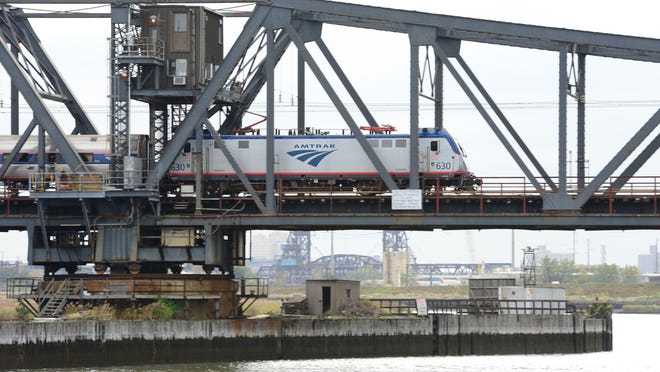
Thursday’s announcement comes on the first anniversary of President Joe Biden’s installation in the Oval Office. Biden, who campaigned on his love of Amtrak and the need for major infrastructure investments, and his administration accelerated the grant application for this project, which some have deemed the most urgent infrastructure project in the country.
Biden visited the construction site of the Portal Bridge replacement in October, weeks after NJ Transit awarded the contract to Skanska.
The financing plan for Gateway’s first phase requests nearly $5.5 billion in federal funds, about 44% of the total project cost. Amtrak committed nearly $1.3 billion, the Port Authority of New York and New Jersey will chip in $2.1 billion, and the remaining $3.35 billion would be split using state funds from New York and New Jersey.
Controversy has brewed in recent years about whether the Gateway cost is justified, and former New York Gov. Andrew Cuomo proposed alternative methods to rehabilitate and replace the tunnels.
Despite that, the board of commissioners in the newly created Gateway Development Commission, a bistate agency that will oversee the construction and spending on the project, applauded this step. The commissioners represent Amtrak, New York and New Jersey.
“We’ll continue to work hard with our federal partners to meet the requirements of the grant so we can get to a Full Funding Grant Agreement rapidly, and move to full construction that finally stops the delays that are costing our commuters and travelers thousands of hours in lost time and the nation billions in productivity,” a statement from the commissioners said.
New Jersey Transit plans to use federal funds it will receive under President Joe Biden’s infrastructure law to build a Hunter Flyover, which would improve the connection between Raritan Valley Line and the Northeast Corridor.
Hudson River rail tunnel gets green light from the feds to start building it
A major and final bureaucratic hurdle has been cleared by the Gateway Tunnel project after the U.S. Army Corps Of Engineers issued a permit to allow construction of the tunnel and tracks through the Meadowlands and under the Hudson River.
We need a regional transit fare card that works in N.J. and NYC, advocates say
While drivers have E-ZPass to let them pay tolls electronically, transit riders are still fumbling with tickets and fare cards — some dating back to the last century — that have limited use.

There was hope that baby steps could be taken toward a regional fare payment system — that would work on mass transit in New Jersey and New York — earlier this week, when the 13-mile PATH rail system approved almost $100 million to create a tap-and-go system and fare card. But those hopes have now been dashed.
Transit agencies could increase ridership if is ticketing is less complicated, advocates said.
Gateway tunnel construction likely to start in 2023, transit officials say
By: Daniel J. Munoz of NJBIZ
November 17, 2021 8:11 am
Transportation officials said they expect construction on the $12 billion Hudson River rail tunnel to start in 2023, now that funding is all but certain following the enactment of the landmark $1.2 trillion federal infrastructure package.
“With the dollars and loan benefits available in the federal infrastructure bill and the analysis of underground conditions we are undertaking, the project is taking big steps toward the start of full construction,” said Balpreet Grewal-Virk, co-chair and the New Jersey commissioner for the Gateway Development Commission, in a Nov. 16 statement. GDC is overseeing the $30 billion Gateway project.
That project includes the $1.56 billion replacement of the century-old Portal North Bridge over the Hackensack River, a swing draw bridge which often becomes a choke point for one of the nation’s busiest stretches of rail.
The tunnel had been held up for years under the Trump administration despite funding agreements put in place by former President Barack Obama, a Democrat.
Critics charged that then-President Donald Trump’s opposition to funding – and the slow-walking of the environmental review process – was political retribution against then-Senate Minority Leader Chuck Schumer, a New York Democrat and Trump critic.
The North River Tunnel. – AMTRAK
Like the bridge, the tunnel is more than a century old and in dire need of repair, especially after damage caused by Superstorm Sandy in 2012. Both are critical links in the Northeast Corridor, a stretch of rail between Boston and Washington, D.C. It’s used by its owners Amtrak and in New Jersey by New Jersey Transit.
Advocates warn that if the tunnel goes offline in even one direction, it could cripple the regional economy and force commuters to use other modes of transportation.
“When it works, the Northeast Corridor fully functions. People get to work on time. Our economy moves forward,” Gov. Phil Murphy said during President Joe Biden’s visit to New Jersey in October. “When it doesn’t, the Northeast Corridor, the people it carries, and all the economic activity it supports, comes to a screeching halt.”
“Over the recent past, that’s happened more and more often.”
Under the $1.2 trillion infrastructure package Biden signed Nov. 15, Amtrak is getting $30 billion for NEC improvements, and $11 billion in other grants.
U.S. Rep. Tom Malinowski, in a statement, said the bill essentially assures that the tunnel will finally move forward and that it will be financed.
“As President Biden signs the Infrastructure Investment and Jobs Act into law today, New Jerseyans can expect to see billions of dollars for our state’s infrastructure – from repairing roads and bridges, to replacing lead pipes and cleaning Superfund Sites, and advancing the Gateway Project,” added Sen. Cory Booker at a press conference this Monday, hours before Biden approved the bill.
The state could get an estimated $12.3 billion for all those infrastructure projects, according to the offices of Booker and Sen. Robert Menendez, both Democrats.
Transportation Secretary Pete Buttigieg visits Union County
Commissioners Al Mirabella, Kimberly Palmieri-Mouded, and Bette Jane Kowalski, along with Congressman Tom Malinowski, welcomed Transportation Secretary Pete Buttigieg to Union County for an infrastructure round table which stressed the importance of the Gateway Project, One Seat Ride, and other key items in the major infrastructure bill currently up for a vote in Congress.
If it passes into the law, the bill will be the most significant public works project in American history.
New Video Highlights Urgency Behind Initial Gateway Program Projects
Focus on benefits of Hudson Tunnel and Portal North Bridge Projects
Newark – With the Federal environmental review process now complete and a renewed wave of momentum behind the Gateway Program, the Gateway Development Commission today released a new video on social media highlighting the benefits of the program’s initial projects, the Portal North Bridge and Hudson Tunnel Projects.
Against the backdrop of the national conversation on infrastructure, the condensed 2-minute video provides a window into the commuter experience through interviews with actual riders who describe what “reliability” – or lack of it – means to their daily lives.
“Those are the conditions we have to accept to be able to support our families,” one commuter says on the video. “Having a reliable commute makes the rest of the day, for any person, a lot better,” says another.
The video includes historical context on the century-old assets at the heart of Gateway. It ends on an inspirational note, outlining a vision for the future that highlights thousands of new jobs and a greener, safer, more modern travel experience between New York and New Jersey.
The video can be accessed via the Gateway Program website, here.
# # #
The Gateway Program is the most urgent infrastructure program in the country – a comprehensive set of rail investments that will improve commuter and intercity services, add needed resiliency and create new capacity for the busiest section of the Northeast Corridor (NEC). The NEC is the most heavily used passenger rail line in the country hosting more than 2,200 train movements and 800,000 passenger trips daily.
Late Show with Stephen Colbert – What Would You Do With $1.2 Trillion? Sec. Buttigieg Has Big Plans For America’s Infrastructure
Build Gateway Now Coalition Applauds Biden Administration for Advancing Hudson Tunnel Project
NEW YORK, NY — Today, the Build Gateway Now Coalition thanked the Biden Administration for advancing the Hudson Tunnel project by swiftly issuing a positive Record of Decision (ROD) on the tunnel’s Environmental Impact Statement (EIS). The ROD — a crucial step forward for the project — allows important pre-construction work, such as property acquisition, to take place. The Hudson Tunnel Project — which involves the construction of a new Hudson River rail tunnel serving Penn Station New York and the rehabilitation of the existing Sandy-damaged North River Tunnel — has major national transportation implications.
In the more than three years since the Final Administrative Draft of the EIS was submitted to U.S. DOT in February of 2018, the Build Gateway Now Coalition has worked diligently to keep the Hudson Tunnel EIS in the public eye. The Coalition unveiled a “count-up clock” to mark the time that passed since the U.S. DOT’s own deadline at a press conference at New York Penn Station. The Build Gateway Now Coalition has also spoken with elected officials, sent letters to elected officials, and issued numerous public statements in support of advancing the Hudson Tunnel Project.
The Coalition looks forward to supporting the next steps in the project, including a full funding agreement for the Hudson Tunnel Project and the advancement of other Gateway Program elements. The Coalition will also support other major investments in our rail infrastructure, including the passage of the American Jobs Plan, which is essential to rebuilding our outdated and crumbling infrastructure.
“For decades, RPA has strongly advocated for better rail service between New York and New Jersey as a vital link that lifts up our regional and national economy,” said Tom Wright, President & CEO for the Regional Plan Association. “We are thrilled to see the environmental review process for the Hudson Tunnel project finally completed. RPA would like to thank Governors Murphy and Cuomo, Senators Schumer, Gillibrand, Booker, and Menendez, as well as the Congressional Delegations for both states for keeping this project in the public eye over the last three years. Our studies have shown just how essential building a new tunnel and effectively repairing the old tunnel are economically and for a good quality of life of our region. We look forward to continuing to push for the competition of the Hudson Tunnel project and other Gateway Program components in the years to come.”
“The New Jersey Chamber of Commerce believes the Gateway Program represents a significant and much needed upgrade to New Jersey’s transportation infrastructure,” said Tom Bracken, President & CEO of the New Jersey Chamber of Commerce. “For New Jersey to remain a competitive state, we must be able to move people and products quickly and efficiently and the Gateway Program will do exactly that. The NJ Chamber thanks the Biden Administration for its quick work in completing and issuing the positive ROD. We hope the rest of the Gateway Program can proceed with equal speed and efficiency. In addition, the NJ Chamber thanks our state’s Congressional delegation for the tenacity and dedication it demonstrated in successfully advocating for the Gateway Project.”
“Gateway is a game-changer for the City, the Region and the Nation,” said General Contractors Association of NY’s Executive Director Robert G. Wessels. “It will take a system built for 20th Century travel and transform it into one that will meet the mobility needs of the 21st Century — and beyond. We look forward to working with the Gateway Development Commission to turn this long-awaited concept into reality for the benefit of generations to come.”
“NAIOP New Jersey is heartened by the Biden Administration’s decision to advance the Hudson Tunnel project. This long-awaited moment will make our region more resilient to future disruptions and help us compete for jobs and talent in the post-COVID economy,” stated NAIOP CEO Michael McGuinness.
“The New York Building Congress applauds the Biden administration and Transportation Secretary Buttigieg for taking this positive step forward on the Gateway Program,” said Carlo A. Scissura, President and CEO of the New York Building Congress. “Getting our region back to normal shouldn’t mean the delayed, over-capacity commutes that far too many were accustomed to long before the pandemic. We must pass the American Jobs Plan to complete the Gateway Program, create tens of thousands of good jobs and get our economy moving like never before.”
Bob Briant, Jr., CEO of the Utility & Transportation Contractors Association said, “The economic stability of our region depends on our ability to efficiently move people, goods, and services across the Hudson River. The Gateway Project is critical to this mobility and as one of the largest public works projects in history, will also support tens of thousands of living wage jobs. New Jersey’s construction community looks forward to the opportunities this long-overdue project offers, and toward building a better future.”
“The Association for a Better New York (ABNY) thanks the Biden Administration for taking action to move this critical project forward. ABNY is grateful for the tireless work of New York’s Congressional delegation and our Coalition partners in making the Hudson River Tunnel project a reality. As we seek a better future for all New Yorkers, this project will enhance productivity, efficiency, safety, reliability, and opportunity for the 21st Century economy,” said Melva M. Miller, Chief Executive Officer, Association for a Better New York (ABNY).
“CIANJ knows that having safe, reliable infrastructure is crucial to our region’s economic health so we commend the Biden Administration for moving the Hudson Tunnel Project forward,” said Anthony Russo, President, Commerce & Industry Association of New Jersey. “This is a critical time for the Gateway Program as transit riders will be returning to the office and ridership will only increase in the coming months. In addition, the Hudson Tunnel Project will also create jobs at a time when many are looking for employment after the devastating impact of the pandemic on our regional economy. Our hope is that the Gateway Program continues to gain momentum and moves forward at this pace after many years of inaction and delays.”
“The Hudson Tunnel project lays the foundation for building a more resilient regional rail network and we are thrilled that the project is moving forward,” said Renae Reynolds, Executive Director of Tri-State Transportation Campaign. “Efficient and robust mass transit is mission critical to our against climate change. Without a new tunnel, the New York City region will not be able to substantially expand rail capacity, which means more traffic congestion on our region’s highways and roads and an increase in toxic tailpipe emissions in the air we all breathe.”
“While the pandemic resulted in reduced transit ridership, the need for transit never went away for essential workers. Now that the pandemic is under control, we are starting to see ridership come back, and transit-oriented development will again grow in importance,” said New Jersey Future Director of Research Tim Evans. “This news about the tunnel moving to the next phase couldn’t come soon enough, especially as we work to cut greenhouse gas emissions to stall the effects of climate change, and reliable alternatives to driving play an important role in this effort.”
“The single most important infrastructure project in America lays underneath the Hudson River. Our existing train tunnels — built when the Titanic sailed its maiden voyage — are crumbling, ravaged from the salt water of Hurricane Sandy’s storm surge. The failure to invest in Gateway during the Trump years created years of useless delays, but today we’re turning the page. The Biden Administration green light for Gateway is a win for expanding our rail infrastructure and capacity across New Jersey. As we recover from the pandemic, this is the time to invest in a mass transit future,” said Doug O’Malley, Director of Environment New Jersey.
“After such a lengthy wait, we are incredibly pleased the Biden Administration and Secretary Buttigieg have taken a huge step in moving the Hudson Tunnel project forward,” said Brian Fritsch, Campaign Manager of the Build Gateway Now Coalition. “Post-pandemic we simply can’t go back to the old days of overcrowded trains and massive delays due to old and failing infrastructure. We look forward to advancing all elements of the Gateway Program to make our region more competitive and put well over 80,000 people back to work building the infrastructure we need to thrive.”
About the Build Gateway Now Coalition
Build Gateway Now is a coalition of over 45 civic, labor, business, and elected groups who know Gateway is the nation’s most important infrastructure project and a critical priority for the nation’s economy. Learn more at buildgateway.org or follow us on Twitter @build_gateway.
Coalition members include: Regional Plan Association; ALM Consulting Group; Amalgamated Transit Union (ATU); Association for a Better New York (ABNY); Brookfield Properties; Central Jersey Transportation Forum; Commerce and Industry Association of New Jersey; Duane Morris LLP; ELEC825; Environmental Defense Fund (EDF); Environment NJ; General Contractors Association (GCA); HNTB; Housing Community Development Network of NJ; JPC Group, Inc.; Lotus Equity Group; Menlo Realty Ventures; NAIOP New Jersey; Natural Resources Defense Council (NRDC); New Jersey Future; New Jersey State Chamber of Commerce; New Jersey League of Conservation Voters (NJLCV); New Jersey Policy Perspective; New York Building Congress; New York League of Conservation Voters (NYLCV); Newark Alliance; NEWARK Community Economic Development Corporation; Newark Regional Business Partnership; PACO Technologies Inc.; Partnership for NYC; Princeton University; Raritan Valley Line Mayor’s Alliance, Raritan Valley Rail Coalition; Riders Alliance; Right Track for Long Island Coalition; Siemens; Somerset County Business Partnership; Straphangers Campaign; Tantum Real Estate; The Durst Organization; The Related Companies; Tri-State Transportation Campaign; Two Trees; Utility & Transportation Contractors Association NJ (UTCA of NJ); Vornado Realty Trust; WSP, Yale University
